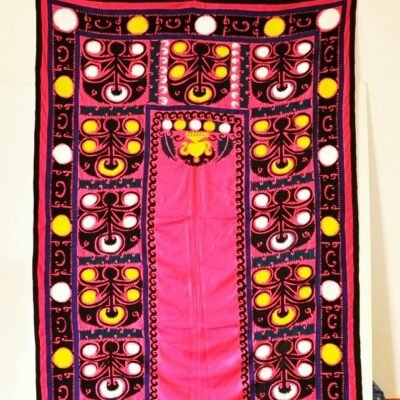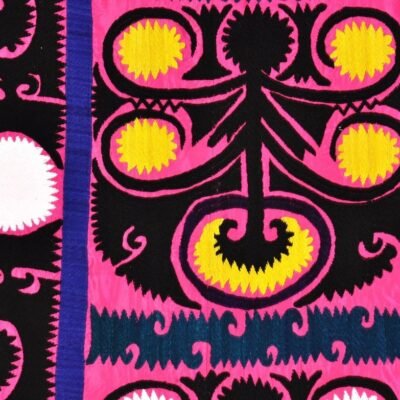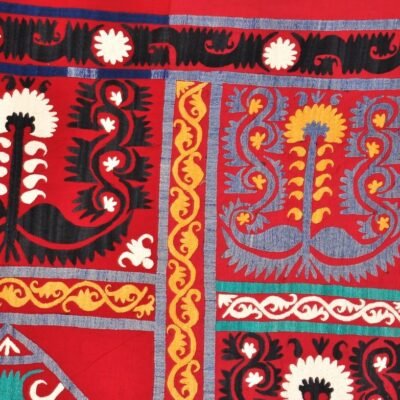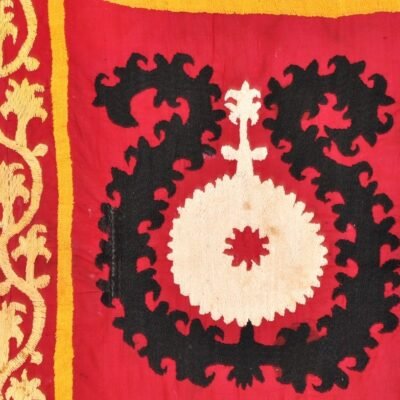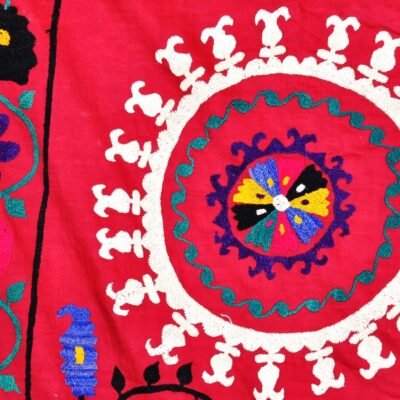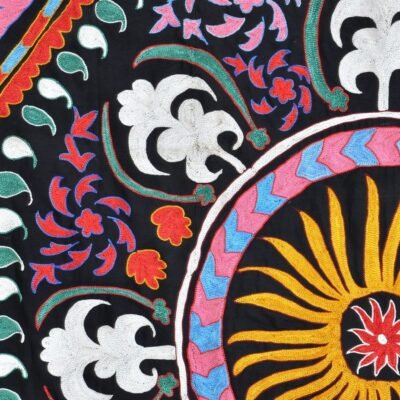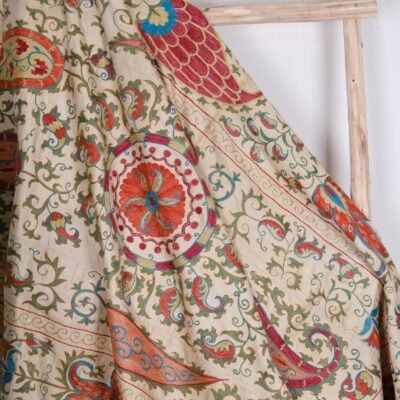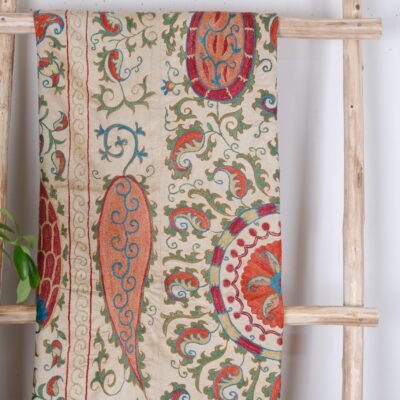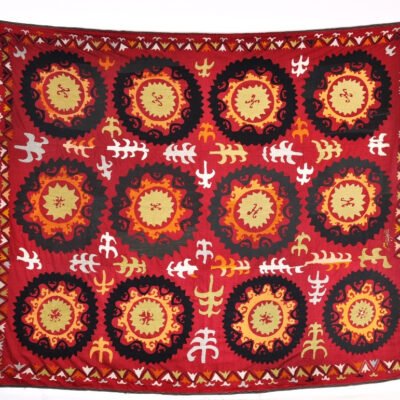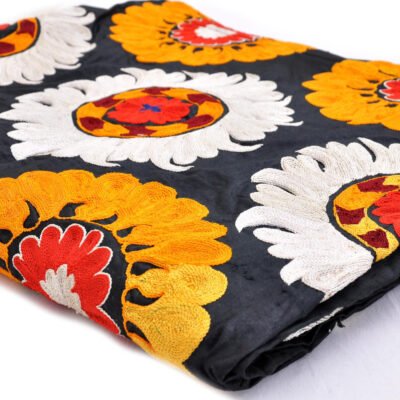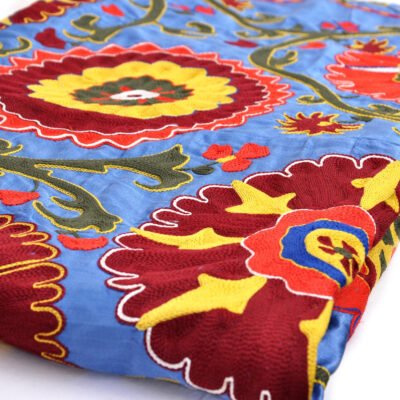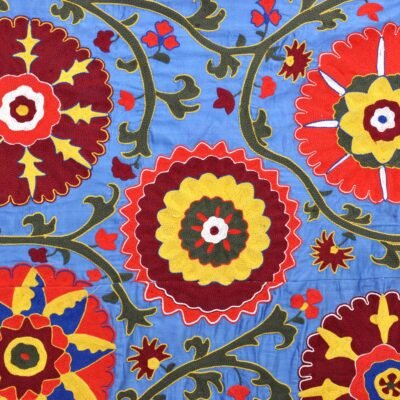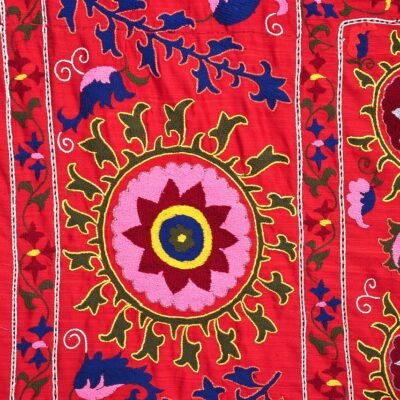Understanding Suzani Patterns: Symbols and Meanings
The motifs in Suzani are not mere decorations; they are a language of symbols, each with a distinct meaning rooted in nature, spirituality, and the daily life of the artisans. Common motifs include sun and moon disks, symbolizing the universe and creation; flowers like tulips, carnations, and irises, representing beauty and divine love; and fruits, especially pomegranates, denoting fertility.
These patterns are more than aesthetic choices; they are blessings woven into the fabric, wishes for luck, health, long life, and prosperity. They serve as a protective charm, warding off evil and bringing joy to the household.
As one embroidery expert beautifully put it, “In the hands of an embroiderer, the fabric becomes a canvas of dreams,” capturing the essence of Suzani as a medium where dreams and traditions are stitched together.
By choosing Alesouk’s authentic Suzani pieces, you’re not just purchasing a product; you’re investing in a piece of history, rich with cultural significance.
Suzani in Modern Decor: Blending Tradition with Contemporary Styles
In the modern home, Suzani textiles serve as a bridge between the past and the present, infusing spaces with a sense of history and artisanal authenticity. Designers and homeowners alike are drawn to Suzani for its timeless appeal and the way it complements contemporary aesthetics.
The intricate patterns of Suzani, steeped in symbolism, bring a narrative depth to the interiors. Each motif, from floral designs to celestial discs, carries with it a story from its nomadic origins, offering more than just visual allure; they provide a connection to the cultural tapestry of Central Asia.
Contemporary artists and designers have embraced Suzani, reinterpreting its traditional motifs to create innovative pieces that resonate with modern tastes. As one designer puts it, "Suzani is the poetry of the needle, where heritage meets modernity, creating a dialogue between eras".
By integrating Suzani into modern interiors, Alesouk offers a unique opportunity to partake in this cultural synthesis. Choosing authentic Suzani from Alesouk not only enhances your space but also supports the artisans and preserves the craft for future generations.
DIY Suzani Projects: Bringing Cultural Craftsmanship Home
Historically, Suzani was more than just a household item; it was a dowry treasure, a symbol of a family’s pride and a bride’s skill. Today, you can honor this tradition by creating your own Suzani-inspired pieces.
Famous textile artist, R. Shavkatovich, speaks to the heart of Suzani’s allure: “In every thread of Suzani, there is life, a pulse of the ancient Silk Road, a stitch from the fabric of history.” His words remind us that when we engage in Suzani DIY projects, we’re not just crafting; we’re connecting with centuries of artisans who have passed down these techniques.
By incorporating Suzani patterns into your DIY endeavors, you’re choosing to make more than just a style statement. Whether it’s through painted furniture, embroidered linens, or stenciled floors, each project is a celebration of the enduring spirit of Suzani craftsmanship.
Suzani Fashion: Incorporating Traditional Embroidery into Modern Wardrobes
Contemporary fashion has embraced Suzani, integrating its traditional motifs and techniques into modern designs. Designers are reinterpreting these patterns to create innovative pieces that resonate with today’s style-conscious individuals, blending heritage with contemporary aesthetics.
The intricate designs of Suzani, once reserved for household textiles, now adorn modern apparel, offering a unique blend of cultural narrative and modern sophistication. As noted by Khalilov Ruslan Shavkatovich, a prominent figure in the study of visual arts, "Suzani patterns carry profound symbolic meaning, essential for understanding the cultural identity of the Uzbek people, and exert a significant influence on modern art and design."
By incorporating Suzani embroidery into everyday wear, fashion enthusiasts can make a bold statement that celebrates the fusion of tradition and innovation. Each piece tells a story, connecting the wearer to the ancient Silk Road’s legacy and the artisans’ enduring spirit.
Preserving Suzani Art: Conservation Efforts and Practices
The preservation of Suzani art is vital for maintaining the cultural heritage of Central Asia. Museums and cultural institutions, like The Metropolitan Museum of Art, play a key role in conserving these textiles, ensuring that the legacy of Suzani embroidery continues to inspire future generations.
Suzani’s preservation is crucial for sustaining the traditional skills and livelihoods of the artisans. Organizations like Ozara, a women’s social enterprise in Tajikistan, support local communities by providing training and employment, thus keeping the craft alive.
Experts emphasize the importance of preserving Suzani motifs and techniques, as they carry profound symbolic meaning and are essential for understanding the cultural identity of the Uzbek people. Khalilov Ruslan Shavkatovich, a visual arts scholar, notes that Suzani embroidery reflects the cultural and historical shifts of Central Asia and exerts a significant influence on modern art and design.
By preserving Suzani art, we not only safeguard a unique form of decorative art but also protect the stories and traditions it represents. This effort supports the economy and social stability of the region, particularly among women, and promotes Uzbek culture on a global scale.
Suzani Embroidery Techniques: A Closer Look at the Craft
The foundation of Suzani lies in its techniques—chain, satin, and buttonhole stitches form the core, with extensive use of couching, where a second thread secures a decorative thread laid on the fabric.
Artisans often create Suzanis in multiple pieces, later stitched together to form a cohesive tapestry. This method allows for the collaborative nature of the craft, where several artisans contribute to a single piece, each adding their unique touch.
The motifs—sun and moon disks, flowers, leaves, vines, and fruits—are not just decorative elements but carry deep symbolic meanings, representing creation, beauty, and life. The artisans, custodians of this heritage, are the ones who keep the craft alive, passing down their knowledge through generations.
Choosing authentic Suzani from Alesouk means more than owning a piece of art; it’s about preserving a tradition. As one expert puts it, “In the hands of an embroiderer, the fabric becomes a canvas of dreams,” highlighting the transformative power of Suzani embroidery.
By supporting Alesouk, you’re ensuring that these artisans continue to weave their dreams into reality, keeping the Suzani spirit vibrant and alive.
Global Influence of Suzani: From Decor to Fashion
Historically, Suzani played a crucial role in the domestic and social lives of Central Asian people, with its patterns believed to carry talismanic messages.
As trade routes expanded, Suzani gained international recognition, particularly during the 18th and 19th centuries, connecting Central Asia with Europe, the Middle East, and beyond. This exposure led to a fusion of styles and techniques, influencing both decor and fashion on a global scale.
In modern times, Suzani has been burning up design blogs, evolving from hand-embroidered patterns to printed products used in various decor applications. Contemporary artists and designers have reinterpreted traditional techniques and motifs, creating innovative and modern pieces that blend heritage with contemporary aesthetics.
This has led to a new appreciation for Suzani in the fashion industry, where its patterns are now seen on runways and in streetwear, offering a unique style statement that resonates with today’s diverse audiences.
Khalilov Ruslan Shavkatovich, a visual arts scholar, emphasizes Suzani’s profound symbolic meaning and its significant influence on modern art and design. He notes that Suzani embroidery reflects the cultural and historical shifts of Central Asia and garners increasing international interest, promoting Uzbek culture on a global scale.
By embracing Suzani, the fashion and decor industries not only celebrate a rich cultural narrative but also contribute to the preservation of traditional crafts. This global influence underscores the importance of Suzani as a form of decorative and applied art, adapting to contemporary conditions and globalization.
Why Suzani Is More Than Decor: Its Impact on Lifestyle and Interior Design
Suzani’s rich patterns and vibrant colors bring a narrative to spaces, telling stories of heritage and artisanal craftsmanship. Its use in modern interiors is a testament to its versatility and timeless appeal, fitting seamlessly into various styles, from eclectic to traditional.
Interior designers and homeowners cherish Suzani for its bohemian luxury and the way it adds gravitas to a space. It’s not just about aesthetics; it’s about bringing a piece of history and culture into the home, creating a connection to the past that resonates in the present.
The motifs in Suzani—florals, vines, and geometric shapes—symbolize luck, protection, and prosperity. They are more than just designs; they are blessings woven into the fabric, presenting a dialogue between the ancient Silk Road and contemporary design philosophies.
Kit Kemp, a renowned interior designer, celebrates the use of Suzani textiles, noting their ability to bridge the gap between the past and the present, offering handcrafted beauty and historical significance to contemporary spaces.
By incorporating Suzani into interior design, one embraces a lifestyle that values the handmade, the meaningful, and the storied. It’s a choice that reflects a commitment to sustainability and a preference for items with a tale to tell.
Suzani’s influence on lifestyle and interior design is profound. It encourages a design ethos that honors craftsmanship, cherishes stories, and respects the cultural narratives that textiles like Suzani carry. It’s a celebration of global craftsmanship, a nod to the nomadic tribes who created them, and a commitment to keeping their artistry alive in our modern world.
Why Choose Alesouk for Authentic Suzani Embroidery?
Purchasing Suzani embroidery directly from Alesouk not only guarantees you receive authentic, high-quality pieces but also supports skilled artisans who craft each piece by hand. Unlike mass-market platforms like Etsy, Christie’s, or Amazon, Alesouk offers a direct link to the heritage and stories behind each Suzani piece.
This provides fair compensation for artisans and contributes to the preservation of this exquisite craft. Alesouk ensures that you receive a piece of art that carries a piece of history, making it more than just a decorative item—it’s a fragment of cultural legacy.



